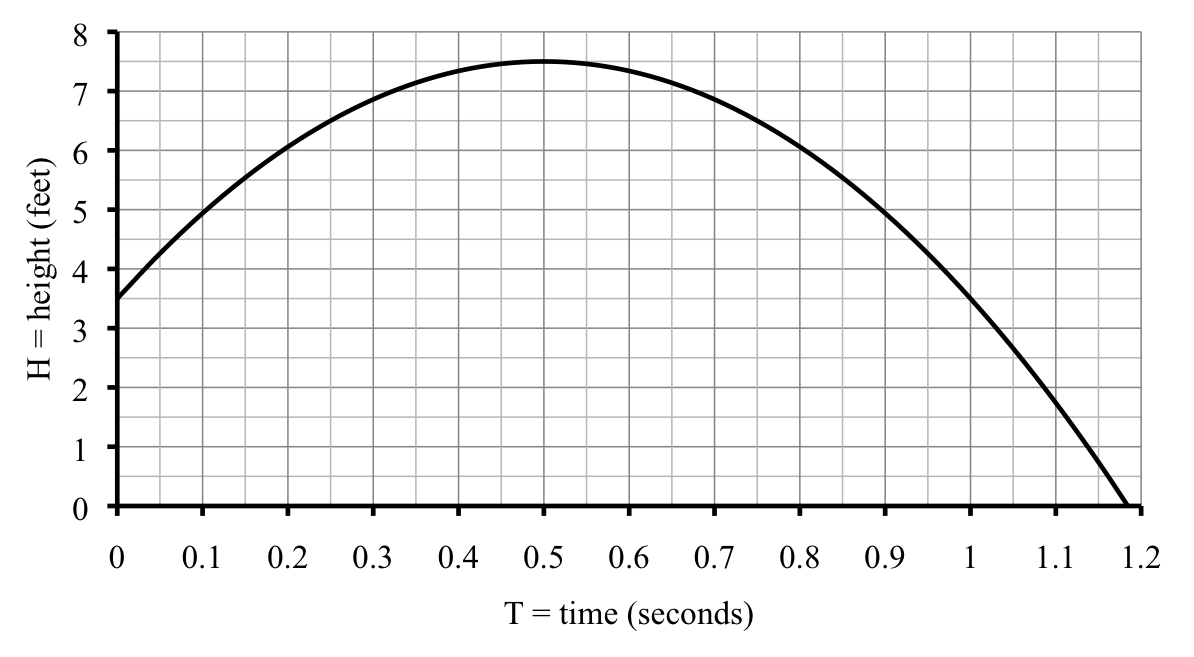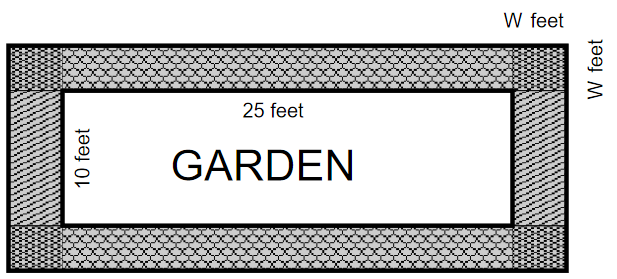Claude likes to juggle. As he throws a beanbag up in the air, the height changes over time as described by the equation
\begin{equation*}
H = 3+15T-16T^2
\end{equation*}
where
\begin{align*}
H \amp= \text{ height of beanbag (feet) } \sim \text{ dep} \\
T \amp= \text{ time (seconds) } \sim \text{ indep}
\end{align*}
Let’s make a table and graph this function. For example, when \(T=0\) seconds we have
\begin{equation*}
H = 3 + 15 \ast 0-16 \ast 0^2 = 3 + 15 \times \underline{0} - 16 \times \underline{0} \wedge 2 = 3 \text{ feet}
\end{equation*}
and when \(T=1\) second we have
\begin{equation*}
H = 3 + 15 \ast 1-16 \ast 1^2 = 3 + 15 \times \underline{1} - 16 \times \underline{1} \wedge 2 = 2 \text{ feet}
\end{equation*}
Huh? I thought the beanbag went up in the air. What’s happening here? Oh, I know. The beanbag must be falling down by then. As we fill in the table with intermediate values we see how Claude’s beanbag went up in the air and then back down.
| \(T\) |
0 |
0.1 |
0.2 |
0.3 |
0.4 |
0.5 |
0.6 |
0.7 |
0.8 |
0.9 |
1 |
1.1 |
1.2 |
| \(H\) |
3 |
4.34 |
5.36 |
6.06 |
6.44 |
6.50 |
6.34 |
5.66 |
4.76 |
3.54 |
2 |
0.14 |
\(\cancel{-2.04}\) |
Notice by
\(T=1.2\) seconds we got
\(-2.04\) feet. We can’t have negative feet. The beanbag must hit the ground before 1.2 seconds. From the graph I’d say in just over 1.1 seconds.
Of course, we can refine our answer by successive approximations. The beanbag hits the ground when its height is 0 feet. Looks a little strange but we want
\(H =0\text{.}\) We expect the answer is just a little bigger than 1.1, so we start our guess optimistically with 1.11.
| \(T\) |
1.1 |
1.11 |
1.105 |
1.107 |
1.106 |
| \(H\) |
0.14 |
\(\cancel{-0.06}\) |
0.0368 |
\(\cancel{-0.002}\) |
0.018 |
| vs. 0 |
high |
low |
high |
low |
good |
The beanbag was in the air for approximately 1.106 seconds.
In this chapter we’ve seen how to solve linear, power, and exponential equations. Let’s solve this equation too. By the way, our function is quadratic because
\begin{equation*}
H = 3+15T-16T^2
\end{equation*}
fits the template for a quadratic equation.
Quadratic Equation Template
\begin{equation*}
\text{dep} = a \ast \text{indep}^2 + b \ast\text{indep} + c
\end{equation*}
with constants
\begin{equation*}
a = -16 \quad b = 15 \quad c = 3
\end{equation*}
(More on how we found those numbers in a moment.)
Back to our juggler. We are trying to figure out when \(H=0\text{.}\) Using our equation \(H=3+15T-16T^2\text{,}\) we get
\begin{equation*}
3+15T-16T^2=0
\end{equation*}
We want to solve for \(T\text{.}\) Notice that because \(T\) occurs twice in the equation, nothing we have seen to do to each side of the equation can knock it down to just one \(T\text{.}\) That means none of our methods so far work. Luckily there’s a way to solve any quadratic equation using the aptly-named Quadratic Formula.
Quadratic Formula
Oh my! First thing to understand in this complicated formula is that we actually get two possible answers
\begin{equation*}
T = \frac{-b}{2a}+ \frac{\sqrt{b^2-4ac}}{2a} \quad \text{and} \quad T = \frac{-b}{2a} - \frac{\sqrt{b^2-4ac}}{2a}
\end{equation*}
Sometimes one answer makes sense in the story, other times they both might. Stay tuned.
For Claude’s situation we had
\begin{equation*}
3+15T-16T^2=0
\end{equation*}
To fit the formula, we need the \(T^2\) first, the \(T\) second, and then the constant. No sweat, just reorder to get
\begin{equation*}
-16T^2 + 15T + 3=0
\end{equation*}
Notice how subtracting \(16T^2\) became adding \(-16T^2\) when we rearranged? That lines up perfectly with
\begin{equation*}
aT^2+bT+c=0
\end{equation*}
That’s how we knew the constants were
\begin{equation*}
a = -16 \quad b = 15 \quad c = 3
\end{equation*}
The first fraction in the formula is
\begin{equation*}
\frac{-b}{2a} = \frac{-15}{2\ast-16} = \text{(-)}15 \div (2 \times \text{(-)}16) = 0.46875
\end{equation*}
As usual, we needed parentheses around the denominator (bottom) of our fraction to override the normal order of operations. As a reminder, (-) refers to negation. Remember, this does not mean you type in parentheses, just hit the one key that is labeled already.
The second fraction is
\begin{align*}
\frac{\sqrt{b^2-4ac}}{2a} \amp = \frac{\sqrt{(15)^2-4 \ast -16 \ast 3}}{2 \ast-16}\\
\amp = \sqrt{~} ( (15) \wedge 2 - 4 \times \text{(-)}16 \times 3) \div (2 \times \text{(-)}16)\\
\amp = -0.6381431\ldots \approx -0.63814
\end{align*}
Check out the parentheses now. Three sets here. First, around the quantity we’re taking the square root of. Maybe your calculator included the open parentheses along with the square root, but either way we need them. Second, around the number (15) that we are squaring. That didn’t matter here but if \(b\) were negative it would have. Last, we added parentheses around the bottom of the fraction, as always.
Oh, and we’re not done yet. Remember there are two possible answers. One is the sum of these two numbers
\begin{equation*}
0.46875 + \text{(-)}0.43814 = -0.46939 \text{ seconds}
\end{equation*}
which doesn’t make any sense because time is never negative. The other is the difference
\begin{equation*}
0.46875 - \text{(-)}0.43814 = 1.10689 \text{ seconds}
\end{equation*}
We had guessed around 1.106 seconds, so that is definitely the right answer: Claude’s beanbag will hit the ground after 1.10689 seconds. Yeah, too precise. But you get the idea.
Wait a minute! Any good juggler isn’t about to let the beanbag fall on the ground. He’s going to catch it again, perhaps at about \(3\tfrac12\) feet above ground. That means we’re looking for \(H=3.5\text{.}\) Using our equation \(H=3+15T-16T^2\text{,}\) we get
\begin{equation*}
3+15T-16T^2=3.5
\end{equation*}
The
Quadratic Formula only works if the equation has
\(=0\text{,}\) but we have
\(=3.5\text{.}\) It might seem that we’re out of luck, but it’s an easy fix. Just subtract 3.5 from each side.
\begin{equation*}
\begin{array}{lcr}
\phantom{-3.}3+1.5T-16T^2 \amp = \amp \cancel{3.5} \\
-3.5 \amp \amp -\cancel{3.5}
\end{array}
\end{equation*}
which simplifies to
\begin{equation*}
-0.5+15T -16T^2 = 0
\end{equation*}
So now we have \(=0\text{.}\) Yes!
We can write the new equation as
\begin{equation*}
-16T^2 + 15T -0.5= 0
\end{equation*}
from which we see that
\begin{equation*}
a = -16 \quad b = 15
\end{equation*}
as before, but now we have a new value
\begin{equation*}
c=-0.5
\end{equation*}
The first fraction is
\begin{equation*}
\frac{-b}{2a} = \frac{-(15)}{2 \ast -16} = \text{(-)}15 \div (2 \times \text{(-)}16) = 0.46875
\end{equation*}
No surprise here. We used the same values of \(a\) and \(b\) as before, so we should have the same number here. The second fraction is
\begin{align*}
\frac{\sqrt{b^2-4ac}}{2a} \amp= \frac{\sqrt{(15)^2-4 \ast -16 \ast -0.5}}{2 \ast-16}\\
\amp= \sqrt{~} ( (15) \wedge 2 - 4 \times \text{(-)}16 \times \text{(-)}0.5) \div (2 \times \text{(-)}16)\\
\amp= -0.43413887\ldots \approx -0.43414
\end{align*}
Don’t forget we need to put together these parts to find the possible answers. The sum gives us
\begin{equation*}
0.46875 + \text{(-)}0.43414 = 0.03461 \approx 0.03 \text{ seconds}
\end{equation*}
and the difference gives us
\begin{equation*}
0.46875 - \text{(-)}0.43414 = 0.90289 \approx 0.9 \text{ seconds}
\end{equation*}
Both answers seem to make sense. Let’s look at the graph to confirm that they’re reasonable. We first find
\(H=3.5\) while the beanbag is going up in the air, just before the unlabeled gridline for 0.05 (midway between 0 and 0.1) so an answer of
\(T\approx 0.03\) makes sense. Then, on the way back down, the beanbag is 3.5 feet up at what looks like 0.9 seconds, so our answer of
\(T \approx 0.9\) makes sense too. Since Claude catches the beanbag on the way down, we want that second answer, after 0.90289 seconds (which is just before 1.106 seconds when it hits the ground, by the way).
One interesting note. What happens in the story at the point where the beanbag stops going up in the air and starts falling down? That must be when the beanbag is at its highest point. What is the speed at that highest point? Well, I guess 0. For a split second it’s almost frozen in midair, neither rising nor falling. (If we were able to compute the rate of change for a really, really small interval of time then we would find the rate of change
\(\approx 0\text{.}\))
Turns out it’s easy to find that point for a quadratic equation, just plug in the first fraction from the Quadratic Formula! Check it out. When
\begin{equation*}
T = \frac{-b}{2a} = \frac{-15}{2 \ast -16}= \text{(-)}15 \div (2 \times \text{(-)} 16)= 0.46875 \text{ seconds}
\end{equation*}
we get
\begin{align*}
H \amp= 3 + 15 \ast 0.46875-16 \ast 0.46875^2\\
\amp= 3 + 15 \times \underline{0.46875} - 16 \times \underline{0.46875} \wedge 2\\
\amp= 6.515625\ldots \approx 6.516 \text{ feet}
\end{align*}
Claude throws the beanbag about 6.516 feet up. Converting to more normal units we get
\begin{equation*}
0.516 \cancel{\text{ feet}} \ast \frac{12 \text{ inches}}{\cancel{\text{ feet}}} = 0.516 \times 12 = 6.192 \approx 6 \text{ inches}
\end{equation*}
The beanbag goes up to about 6′6″. You can check that the graph shows just over 6.5 feet.
In general, the graph of
\(H = aT^2+bT+c\) is a
parabola. The two solutions from the
Quadratic Formula are both places where
\(H=0\) (we give them the fancy name
roots) and, so, the graph crosses the
\(T\)-axis there. Might not make sense in the real problem, but the equation and formula don’t know that. (Okay, equations and formulas don’t actually “know” anything. But you get my point.) Turns out the graph is symmetric about the highest point, so that must be midway in between the roots which is exactly where
\begin{equation*}
T =\frac{-b}{2a}
\end{equation*}
Because \(a\) is negative, the answer we got by adding is to the left and the answer we got by subtracting is to the right.
Our graph was a
\(\cap\) shaped parabola and so we found a
maximum value. The graph of a quadratic function might be
\(\cup\) shaped instead. In that case evaluating at
\(T=\frac{-b}{2a}\) would give the
minimum value.


